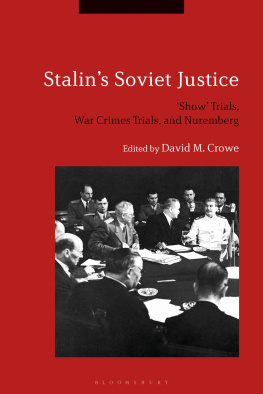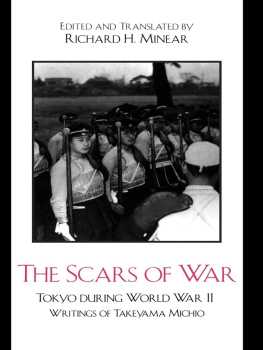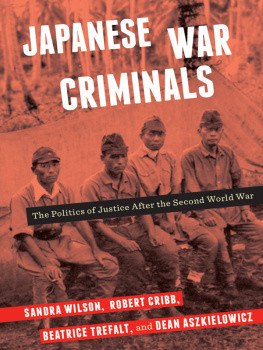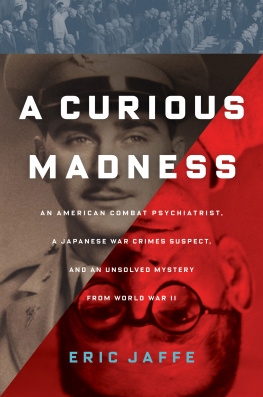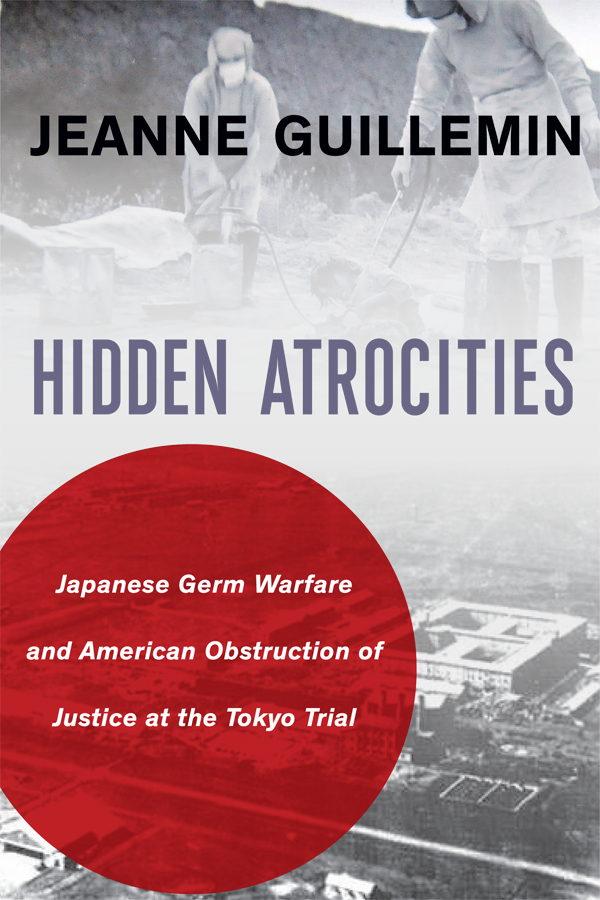Contents
Guide
Pagebreaks of the print version
HIDDEN ATROCITIES
A Nancy Bernkopf Tucker and Warren I. Cohen Book on American-East Asian Relations

Edited by
Thomas J. Christensen
Mark Philip Bradley
Rosemary Foot
Michael J. Green, By More Than Providence: Grand Strategy and American Power in the Asia Pacific Since 1783
Nancy Bernkopf Tucker was a historian of American diplomacy whose work focused on AmericanEast Asian relations. She published seven books, including the prize-winning Uncertain Friendships: Taiwan, Hong Kong, and the United States, 19451992 . Her articles and essays appeared in countless journals and anthologies, including the American Historical Review , Diplomatic History , Foreign Affairs , and the Journal of American History . In addition to teaching at Colgate and Georgetown (where she was the first woman to be awarded tenure in the School of Foreign Service), she served on the China desk of the Department of State and in the American embassy in Beijing. When the Office of the Director of National Intelligence was created, she was chosen to serve as the first Assistant Deputy Director of National Intelligence for Analytic Integrity and Standards and Ombudsman, and she was awarded the National Intelligence Medal of Achievement in 2007. To honor her, in 2012 the Woodrow Wilson International Center for Scholars established an annual Nancy Bernkopf Tucker Memorial Lecture on U.S.East Asian Relations.
Warren I. Cohen is University Distinguished Professor Emeritus at Michigan State University and the University of Maryland, Baltimore County, and a senior scholar in the Asia Program of the Woodrow Wilson Center. He has written thirteen books and edited seven others. He served as a line officer in the U.S. Pacific Fleet, editor of Diplomatic History , president of the Society for Historians of American Foreign Relations, and chairman of the Department of State Advisory Committee on Historical Diplomatic Documentation. In addition to scholarly publications, he has written for the Atlantic , the Baltimore Sun , the Christian Science Monitor , Dissent , Foreign Affairs , the International Herald Tribune , the Los Angeles Times , The Nation , the New York Times , the Times Literary Supplement , and the Washington Post. He has also been a consultant on Chinese affairs to various government organizations.
JEANNE GUILLEMIN
HIDDEN ATROCITIES
Japanese Germ Warfare and American Obstruction of Justice at the Tokyo Trial
COLUMBIA UNIVERSITY PRESS New York

Columbia University Press
Publishers Since 1893
New YorkChichester, West Sussex
cup.columbia.edu
Copyright 2017 Jeanne Guillemin
All rights reserved
E-ISBN 978-0-231-54498-6
Library of Congress Cataloging-in-Publication Data
Names: Guillemin, Jeanne, 1943- author.
Title: Hidden atrocities : Japanese germ warfare and American obstruction of justice at the Tokyo Trial / Jeanne Guillemin.
Description: New York : Columbia University Press, 2017. | Series: The Nancy Bernkopf Tucker and Warren I. Cohen books on American-East Asian relations | Includes bibliographical references and index.
Identifiers: LCCN 2016057961 (print) | LCCN 2016059683 (ebook) | ISBN 9780231183529 (cloth : alk. paper) | ISBN 9780231544986 (electronic)
Subjects: LCSH: Tokyo Trial, Tokyo, Japan, 1946-1948 | War crime trialsJapan. | Biological weaponsJapanHistory.
Classification: LCC KZ1181 .G85 2017 (print) | LCC KZ1181 (ebook) | DDC 341.6/90268dc23
LC record available at https://lccn.loc.gov/2016057961
A Columbia University Press E-book.
CUP would be pleased to hear about your reading experience with this e-book at .
Cover image: Xinhua News Agency GettyImages
The history of the world is the judgment of the world.
Friedrich Schiller
CONTENTS
In the autumn of 1940, three years into its war with China, Japan reached a stalemate. In 1937 the Japanese military had begun a drive south from northeastern China, where it ruled the puppet government of Manchukuo (the state of Manchuria). Its forces had occupied Beijing, Tianjin, Shanghai, and the Chinese capital, Nanjing, and gained control of key southern ports. Yet resistance in central China was blocking a total conquest and thwarting the vision of Japanese leaders for a New Order in East Asia that would extend to Indochina, Burma, the Pacific, and beyond.
To break the impasse, the Japanese high command accepted an innovative proposal from the Kwantung Army in Manchukuo, then led by General Umezu Yoshijiro. The army, created in 1918 to guard Japans interests in Manchuria, grew to rule the area like a fiefdom and, in addition to other exploits, oversaw a covert biological warfare research center at Pingfan, just outside the city of Harbin. The fleas would be released with bundles of grain; the rats attracted to the grain would be bitten by the fleas, sicken, and die; then, as in a natural outbreak, the fleas would find human hosts. Or the biting fleas would directly infect the targeted humans, a method of transmission tested with success on captive Chinese and Manchu guinea pigs at Pingfan.
Ishii, a major general in the medical corps, had long relied on powerful supporters like General Umezu to promote his secret program. Another was General Araki Sadao, a former minister of war and in 1940 the minister of education. At the highest level was General Tojo Hideki, the new minister of war. Tojo had spent three years in Manchukuo under General Umezu, first as head of the Secret Police and then as the Kwantung Army chief of staff, and was familiar with Ishiis secret research and mission.
To the Japanese public and to many in the military and government, General Ishii was known only as the head of Pingfans Anti-epidemic Water Purification Bureau (Boeki Kyusuibu), a beneficent supplier of clean water and vaccines for troops in battle. A filtration device Ishii had invented could turn urine into potable water, an invention he liked to claim he had demonstrated to Emperor Hirohito himself. His foremost objective, though, was to conduct experiments with infectious diseases that had potential as germ weapons, like plague, anthrax, cholera, typhus, and glanders.
In 1936 Ishiis venture was reorganized as the Epidemic Prevention Department of the Kwantung Army, with an animal disease branch (under the armys Unit 100) just outside Changchun, the capital of Manchukuo. Ishii moved his research group from its original site at Beiyinhe, 100 kilometers southeast of Harbin, to a new center 30 kilometers outside the city, the complex called Pingfan, where a dozen contiguous villages, including the one called Pingfan, were razed to make room for it. The modern, gated enclave, designated a closed military zone in 1938, covered more than a thousand acres, with 150 buildings, its own airfield, a railway line to Harbin, and a testing ground for model bombs. Pingfan was sustained by medical researchers recruited largely from the Kyoto Imperial Medical School and the Tokyo Army Hospital. Hundreds of soldiers guarded the center and hundreds of Chinese slave workers kept it in working order. The Kempeitai, the local military police, kept General Ishii supplied with captives from jails, Chinese insurgents who had been captured, and unlucky individuals, including Russians, abducted off the street in Harbin into black vans or herded into trains as cargoes of marutas (logs) to the fictional lumber mill behind Pingfans barbed wire.




